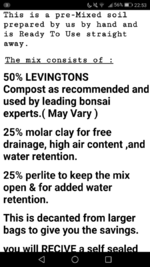I saw another one on eBay that was more 'traditional' I guess you could say it was a blend but mostly akadama, my worry with that was that I've seen videos of Peter Chan on YouTube say in the UK climate and indoors it's not always the best because akadama dries out very quickly and Chinese elm is a species that likes to keep more damp, correct ?
Interesting that Peter Chan believes that akadama dries out. My limited experience with it seemed that akadama stayed too wet for too long. Maybe different grades, maybe different climate, maybe different watering.
Chinese elm is like most other bonsai species - likes some moisture but will get sick if the roots are wet all the time. Some species are able to cope with drier but most need similar water well and then allow the soil to get closer to dry before watering again.
If a soil dries out quickly we just need to match watering frequency to drying. Usually easier to water more often than to get a soggy soil to dry out.
Pumice is marginally heavier than perlite depending on the source but it's usually light enough to float on water. Definitely no need to worry about wind indoors - at least not the kind that blows bonsai off the shelf.
In my experience the problems coming with a wet soil far exceed those that come with forgetting to water. Of course forgetting to water can be a killer too but it's more controllable ;-)
The problem with forgetting to water is that death is very quick - a day is enough to kill a tree. In really hot weather dry for a few hours is enough to kill trees in smaller pots and there's no coming back from dead.
Overwatering takes weeks or months to promote the fungal infections that kill the roots so that happens slow enough to see symptoms and make changes. Treatment, root prune, fresh soil and/or change of care can see many affected trees recover provided a few roots are still alive.
Maybe the problems are relative to local climate. With our very hot, dry summer down here, death from dehydration is far more common than death from root rot so I do better keeping trees slightly on the wet side rather than too dry. S.E. UK is likely to be far cooler and wetter than here so it stands to reason that wet soil is more likely to be a problem than too dry.
I guess that's another reason there's so much dispute about what makes good bonsai soil.
Your local advice on what soils are good and available is valuable. Hope
@Lawrencek takes note and understands that cheap soil may not appear so cheap when the bonsai dies as a result.



